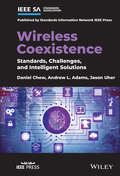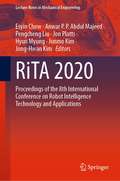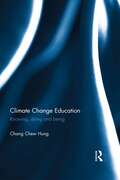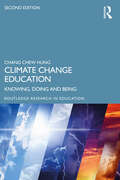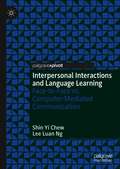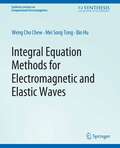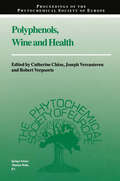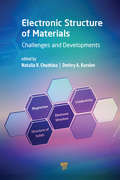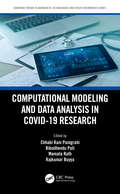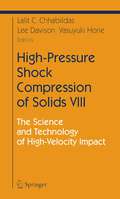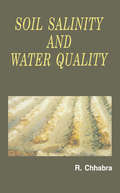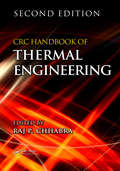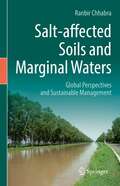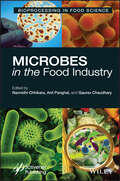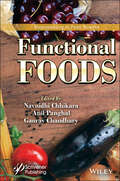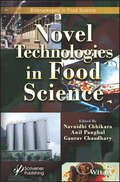- Table View
- List View
Wireless Coexistence: Standards, Challenges, and Intelligent Solutions
by Daniel Chew Andrew L. Adams Jason UherWireless Coexistence Explore a comprehensive review of the motivation for wireless coexistence and the standards and technology used to achieve it Wireless Coexistence: Standards, Challenges, and Intelligent Solutions delivers a thorough exploration of wireless ecosystems sharing the spectrum, including the multiple standards and key requirements driving the current state of wireless technology. The book surveys several standards, including IEEE 802.22, 802.15.2, and 802.19.1 and expands upon recent advances in machine learning and artificial intelligence to demonstrate how these technologies might be used to meet or exceed the challenges of wireless coexistence. The text discusses cognitive radio in the context of spectrum coexistence and provides a comparison and assessment of using artificial intelligence in place of, or in addition to, current techniques. It also considers applications to communication theory, learning algorithms for passive wireless coexistence strategies, spectrum situational awareness, and active wireless coexistence strategies. With the necessity of spectrum sharing and the scarcity of unused spectrum on the rise, the standardization of wireless coexistence becomes more important with each passing day. Readers will learn about the challenges posed by shrinking wireless real estate and from the inclusion of topics like: A thorough introduction to the concept of, and motivation for, wireless coexistence, including congestion and interference, policies, and regulations An exploration of different wireless coexistence standards, including the need for standardization and various protocols, including 802.22, 802.15.2, 802.19.1, P1900, and 3GPP Release 13/14 LAA A discussion of the applications of communication theory, including primary user strategies, primary multi-user protocols, and successive interference cancellation A treatment of concepts in learning algorithms Perfect for scientists, researchers, engineers, developers, educators, and administrators working in the area of wireless networks, Wireless Coexistence: Standards, Challenges, and Intelligent Solutions will also earn a place in the libraries of graduate students studying wireless networks and seeking a one-stop reference for subjects related to wireless coexistence standards.
Wireless Coexistence: Standards, Challenges, and Intelligent Solutions
by Daniel Chew Andrew L. Adams Jason UherWireless Coexistence Explore a comprehensive review of the motivation for wireless coexistence and the standards and technology used to achieve it Wireless Coexistence: Standards, Challenges, and Intelligent Solutions delivers a thorough exploration of wireless ecosystems sharing the spectrum, including the multiple standards and key requirements driving the current state of wireless technology. The book surveys several standards, including IEEE 802.22, 802.15.2, and 802.19.1 and expands upon recent advances in machine learning and artificial intelligence to demonstrate how these technologies might be used to meet or exceed the challenges of wireless coexistence. The text discusses cognitive radio in the context of spectrum coexistence and provides a comparison and assessment of using artificial intelligence in place of, or in addition to, current techniques. It also considers applications to communication theory, learning algorithms for passive wireless coexistence strategies, spectrum situational awareness, and active wireless coexistence strategies. With the necessity of spectrum sharing and the scarcity of unused spectrum on the rise, the standardization of wireless coexistence becomes more important with each passing day. Readers will learn about the challenges posed by shrinking wireless real estate and from the inclusion of topics like: A thorough introduction to the concept of, and motivation for, wireless coexistence, including congestion and interference, policies, and regulations An exploration of different wireless coexistence standards, including the need for standardization and various protocols, including 802.22, 802.15.2, 802.19.1, P1900, and 3GPP Release 13/14 LAA A discussion of the applications of communication theory, including primary user strategies, primary multi-user protocols, and successive interference cancellation A treatment of concepts in learning algorithms Perfect for scientists, researchers, engineers, developers, educators, and administrators working in the area of wireless networks, Wireless Coexistence: Standards, Challenges, and Intelligent Solutions will also earn a place in the libraries of graduate students studying wireless networks and seeking a one-stop reference for subjects related to wireless coexistence standards.
RiTA 2020: Proceedings of the 8th International Conference on Robot Intelligence Technology and Applications (Lecture Notes in Mechanical Engineering)
by Esyin Chew Anwar P. P. Abdul Majeed Pengcheng Liu Jon Platts Hyun Myung Junmo Kim Jong-Hwan KimThis book gathers the Proceedings of the 8th International Conference on Robot Intelligence Technology and Applications (RITA 2020). The areas covered include: Instrumentation and Control, Automation, Autonomous Systems, Biomechatronics and Rehabilitation Engineering, Intelligent Systems, Machine Learning, Mobile Robotics, Social Robotics and Humanoid Robotics, Sensors and Actuators, and Machine Vision, as well as Signal and Image Processing. As a valuable asset, the book offers researchers and practitioners a timely overview of the latest advances in robot intelligence technology and its applications.
Climate Change Education: Knowing, doing and being
by Chang Chew HungClimate change is a controversial topic; some people assert that climate change is not occurring, and others believe that reports are inaccurate, that whilst climate change is happening, it may not be caused by human activity. There are also climate alarmists who use IPCC reports to support their claims that erratic weather patterns are a result of climate change caused by human activity. Regardless of these different viewpoints, one fact can be agreed upon; climate change is a complex subject and there is a need to educate future generations, enabling them to deal with the plethora of information and views that they will experience in their lives. This book explores what education for climate change entails, discussing the concept of Climate Change Education (CCE) itself, how it can be taught in schools and how public education can be carried out. It instructs what specific subject matter to teach for CCE, and how to evaluate the student learning on the subject. Chapters include: CCE in the Formal Curriculum Teacher readiness for CCE Assessment for and of CCE Lessons from CCE for Public Education Climate Change Education is an extremely useful resource for anyone involved in educating students on climate change and also for those interested in climate change itself.
Climate Change Education: Knowing, doing and being
by Chang Chew HungClimate change is a controversial topic; some people assert that climate change is not occurring, and others believe that reports are inaccurate, that whilst climate change is happening, it may not be caused by human activity. There are also climate alarmists who use IPCC reports to support their claims that erratic weather patterns are a result of climate change caused by human activity. Regardless of these different viewpoints, one fact can be agreed upon; climate change is a complex subject and there is a need to educate future generations, enabling them to deal with the plethora of information and views that they will experience in their lives. This book explores what education for climate change entails, discussing the concept of Climate Change Education (CCE) itself, how it can be taught in schools and how public education can be carried out. It instructs what specific subject matter to teach for CCE, and how to evaluate the student learning on the subject. Chapters include: CCE in the Formal Curriculum Teacher readiness for CCE Assessment for and of CCE Lessons from CCE for Public Education Climate Change Education is an extremely useful resource for anyone involved in educating students on climate change and also for those interested in climate change itself.
Climate Change Education: Knowing, Doing and Being (Routledge Research in Education)
by Chang Chew HungClimate change is complex and there is a need to educate our future generations so that they are able to deal with the plethora of information and views that they come into contact with in their lives. This book inquires into what it means to teach and learn about climate change. Now in its second edition, Chang further explores what education for climate change entails, discussing the concept of climate change education (CCE) itself, how it is taught in schools and how public education is being carried out. Featuring updated literature in a quickly advancing field, the book defines CCE for the global citizen and looks at pedagogies supporting CCE. It also identifies teachers as key stakeholders in climate change discourse, how to improve teacher readiness on the topic and how teacher professional development can support successful implementation of CCE. This book will be invaluable to climate change educators and can act as a reference resource for teachers, education policymakers and public education agencies.
Climate Change Education: Knowing, Doing and Being (Routledge Research in Education)
by Chang Chew HungClimate change is complex and there is a need to educate our future generations so that they are able to deal with the plethora of information and views that they come into contact with in their lives. This book inquires into what it means to teach and learn about climate change. Now in its second edition, Chang further explores what education for climate change entails, discussing the concept of climate change education (CCE) itself, how it is taught in schools and how public education is being carried out. Featuring updated literature in a quickly advancing field, the book defines CCE for the global citizen and looks at pedagogies supporting CCE. It also identifies teachers as key stakeholders in climate change discourse, how to improve teacher readiness on the topic and how teacher professional development can support successful implementation of CCE. This book will be invaluable to climate change educators and can act as a reference resource for teachers, education policymakers and public education agencies.
Interpersonal Interactions and Language Learning: Face-to-Face vs. Computer-Mediated Communication
by Shin Yi Chew Lee Luan NgThis book takes as its starting point the assumption that interpersonal communication is a crucial aspect of successful language learning. Following an examination of different communicative models, the authors focus on traditional face-to-face (F2F) interactions, before going on to compare these with the forms of computer-mediated communication (CMC) enabled by recent developments in educational technology. They also address the question of individual differences, particularly learners' preferred participation styles, and explore how F2F and CMC formats might impact learners differently. This book will be of interest to students and scholars of computer-mediated communication (CMC), computer-assisted language learning (CALL), technology-enhanced language learning (TELL), language acquisition and language education more broadly.
Integral Equation Methods for Electromagnetic and Elastic Waves (Synthesis Lectures on Computational Electromagnetics)
by Weng Chew Mei-Song Tong Bin HUIntegral Equation Methods for Electromagnetic and Elastic Waves is an outgrowth of several years of work. There have been no recent books on integral equation methods. There are books written on integral equations, but either they have been around for a while, or they were written by mathematicians. Much of the knowledge in integral equation methods still resides in journal papers. With this book, important relevant knowledge for integral equations are consolidated in one place and researchers need only read the pertinent chapters in this book to gain important knowledge needed for integral equation research. Also, learning the fundamentals of linear elastic wave theory does not require a quantum leap for electromagnetic practitioners. Integral equation methods have been around for several decades, and their introduction to electromagnetics has been due to the seminal works of Richmond and Harrington in the 1960s. There was a surge in the interest in this topic in the 1980s (notably the work of Wilton and his coworkers) due to increased computing power. The interest in this area was on the wane when it was demonstrated that differential equation methods, with their sparse matrices, can solve many problems more efficiently than integral equation methods. Recently, due to the advent of fast algorithms, there has been a revival in integral equation methods in electromagnetics. Much of our work in recent years has been in fast algorithms for integral equations, which prompted our interest in integral equation methods. While previously, only tens of thousands of unknowns could be solved by integral equation methods, now, tens of millions of unknowns can be solved with fast algorithms. This has prompted new enthusiasm in integral equation methods. Table of Contents: Introduction to Computational Electromagnetics / Linear Vector Space, Reciprocity, and Energy Conservation / Introduction to Integral Equations / Integral Equations for Penetrable Objects / Low-Frequency Problems in Integral Equations / Dyadic Green's Function for Layered Media and Integral Equations / Fast Inhomogeneous Plane Wave Algorithm for Layered Media / Electromagnetic Wave versus Elastic Wave / Glossary of Acronyms
Polyphenols, Wine and Health: Proceedings of the Phytochemical Society of Europe, Bordeaux, France, 14th–16th April, 1999 (Proceedings of the Phytochemical Society of Europe #48)
by Catherine ChèzeIn this book, the effect of nutritional habits and wine consumption on ageing and the main degenerative diseases (cardiovascular, cancer, Alzheimer's, etc.) are considered through the most relevant epidemiological and pharmacological studies. Newly isolated wine polyphenols and tannins are presented and their structures and in vitro biological properties are discussed that could strongly support the hypotheses that those molecules could insure beneficial health effects. This book will be of particular interest to people involved in problems of public health, but also in the wine industry or in wine making, as well as to physicians who are concerned by the difficult question of ageing and its related chronic diseases.
Electronic Structure of Materials: Challenges and Developments
by Natalia Chezhina Dmitry KorolevThis book is a short survey of magnetochemistry as a promising method for revealing the electronic structure of inorganic substances, particularly solid oxide materials. It is supported by five chapters that describe materials with various structures and applications, showing how the method of magnetic dilution with the aid of other physical methods (electron spin resonance, magnetization, Raman and Mössbauer spectroscopy, and electrical conductivity), accompanied by thorough structural and quantum mechanical studies, may be used for describing the states of atoms and interatomic interactions in multicomponent oxide systems. The book will serve as a guide for researchers in the field of various oxide materials, since it shows the roots for selecting the best structures and qualitative and quantitative compositions of oxide materials on the basis of the knowledge about their electronic structure. It is devoted to some of the most popular structures of multicomponent oxides among modern materials—perovskites and pyrochlores—giving a unified approach to their chemical structure.
Electronic Structure of Materials: Challenges and Developments
by Natalia Chezhina Dmitry KorolevThis book is a short survey of magnetochemistry as a promising method for revealing the electronic structure of inorganic substances, particularly solid oxide materials. It is supported by five chapters that describe materials with various structures and applications, showing how the method of magnetic dilution with the aid of other physical methods (electron spin resonance, magnetization, Raman and Mössbauer spectroscopy, and electrical conductivity), accompanied by thorough structural and quantum mechanical studies, may be used for describing the states of atoms and interatomic interactions in multicomponent oxide systems. The book will serve as a guide for researchers in the field of various oxide materials, since it shows the roots for selecting the best structures and qualitative and quantitative compositions of oxide materials on the basis of the knowledge about their electronic structure. It is devoted to some of the most popular structures of multicomponent oxides among modern materials—perovskites and pyrochlores—giving a unified approach to their chemical structure.
Computational Modeling and Data Analysis in COVID-19 Research (Emerging Trends in Biomedical Technologies and Health informatics)
by Chhabi Rani Panigrahi, Bibudhendu Pati, Mamata Rath and Rajkumar BuyyaThis book covers recent research on the COVID-19 pandemic. It includes the analysis, implementation, usage, and proposed ideas and models with architecture to handle the COVID-19 outbreak. Using advanced technologies such as artificial intelligence (AI) and machine learning (ML), techniques for data analysis, this book will be helpful to mitigate exposure and ensure public health. We know prevention is better than cure, so by using several ML techniques, researchers can try to predict the disease in its early stage and develop more effective medications and treatments. Computational technologies in areas like AI, ML, Internet of Things (IoT), and drone technologies underlie a range of applications that can be developed and utilized for this purpose. Because in most cases there is no one solution to stop the spreading of pandemic diseases, and the integration of several tools and tactics are needed. Many successful applications of AI, ML, IoT, and drone technologies already exist, including systems that analyze past data to predict and conclude some useful information for controlling the spread of COVID-19 infections using minimum resources. The AI and ML approach can be helpful to design different models to give a predictive solution for mitigating infection and preventing larger outbreaks. This book: Examines the use of artificial intelligence (AI), machine learning (ML), Internet of Things (IoT), and drone technologies as a helpful predictive solution for controlling infection of COVID-19 Covers recent research related to the COVID-19 pandemic and includes the analysis, implementation, usage, and proposed ideas and models with architecture to handle a pandemic outbreak Examines the performance, implementation, architecture, and techniques of different analytical and statistical models related to COVID-19 Includes different case studies on COVID-19 Dr. Chhabi Rani Panigrahi is Assistant Professor in the Department of Computer Science at Rama Devi Women’s University, Bhubaneswar, India. Dr. Bibudhendu Pati is Associate Professor and Head of the Department of Computer Science at Rama Devi Women’s University, Bhubaneswar, India. Dr. Mamata Rath is Assistant Professor in the School of Management (Information Technology) at Birla Global University, Bhubaneswar, India. Prof. Rajkumar Buyya is a Redmond Barry Distinguished Professor and Director of the Cloud Computing and Distributed Systems (CLOUDS) Laboratory at the University of Melbourne, Australia.
High-Pressure Shock Compression of Solids VIII: The Science and Technology of High-Velocity Impact (Shock Wave and High Pressure Phenomena)
by L. C. Chhabildas Lee Davison Y. HorieResearch in the field of shock physics and ballistic impact has always been intimately tied to progress in development of facilities for accelerating projectiles to high velocity and instrumentation for recording impact phenomena. The chapters of this book, written by leading US and European experts, cover a broad range of topics and address researchers concerned with questions of material behaviour under impulsive loading and the equations of state of matter, as well as the design of suitable instrumentation such as gas guns and high-speed diagnostics. Applications include high-speed impact dynamics, the inner composition of planets, syntheses of new materials and materials processing. Among the more technologically oriented applications treated is the testing of the flight characteristics of aeroballistic models and the assessment of impacts in the aerospace industry.
Soil Salinity and Water Quality
by R. ChhabraThis volume covers such areas in the field of soil salinity and water quality as: origin and distribution of salt-affected soils; management of alkali soils; quality criteria of irrigation water; wastewaters as a source of irrigation; and grasses and trees in the management of salt-affected soils.
Soil Salinity and Water Quality
by R. ChhabraThis volume covers such areas in the field of soil salinity and water quality as: origin and distribution of salt-affected soils; management of alkali soils; quality criteria of irrigation water; wastewaters as a source of irrigation; and grasses and trees in the management of salt-affected soils.
CRC Handbook of Thermal Engineering (Mechanical and Aerospace Engineering Series)
by Raj P. ChhabraThe CRC Handbook of Thermal Engineering, Second Edition, is a fully updated version of this respected reference work, with chapters written by leading experts. Its first part covers basic concepts, equations and principles of thermodynamics, heat transfer, and fluid dynamics. Following that is detailed coverage of major application areas, such as bioengineering, energy-efficient building systems, traditional and renewable energy sources, food processing, and aerospace heat transfer topics. The latest numerical and computational tools, microscale and nanoscale engineering, and new complex-structured materials are also presented. Designed for easy reference, this new edition is a must-have volume for engineers and researchers around the globe.
CRC Handbook of Thermal Engineering (Mechanical and Aerospace Engineering Series)
by Raj P. ChhabraThe CRC Handbook of Thermal Engineering, Second Edition, is a fully updated version of this respected reference work, with chapters written by leading experts. Its first part covers basic concepts, equations and principles of thermodynamics, heat transfer, and fluid dynamics. Following that is detailed coverage of major application areas, such as bioengineering, energy-efficient building systems, traditional and renewable energy sources, food processing, and aerospace heat transfer topics. The latest numerical and computational tools, microscale and nanoscale engineering, and new complex-structured materials are also presented. Designed for easy reference, this new edition is a must-have volume for engineers and researchers around the globe.
Salt-affected Soils and Marginal Waters: Global Perspectives and Sustainable Management
by Ranbir ChhabraThis book presents systematic scientific appraisal, classification, genesis and viable technologies for reclamation and management of salt-affected soils and marginal quality waters across India and several other countries. Nature, solubility and geo-chemical mobility of salts have been provided as basis for the development of alkali and saline soils and groundwaters under specific agro-hydro-ecological regions. Chemical amendment (gypsum) based reclamation technology of alkali soils and related pre and post-reclamation water, nutrient and crop management interventions, including re-sodification issues have been comprehensively addressed. Features and operational guidelines of surface, subsurface, vertical and bio-drainage systems have been thoroughly discussed; likewise, amelioration of irrigation induced saline soils in inland and coastal regions and preventive measures for control of salinity and waterlogging along with environmental trade-offs. Practical approaches for amelioration and judicious use of saline, alkali, high SAR- saline and waste waters have been synthesized for different cropping and agro- forestry systems. Emerging issues on use of industrial by-products as amendments for alkali soils, physiological aspects of salt resistance, anatomical and biochemical mechanism of submergence tolerance, specific ion effects of poor quality waters, crop diversification, groundwater recharge, rejuvenation of tsunami affected coastal soils, safety against occurrence of poisonous gas in tube well pits, paddy straw burning and others have been adequately deliberated upon. Combining scientific principles with field experiences, the book is expected to serve as a useful knowledge base for research workers, teachers and students of soil science, agronomy, plant breeding, forestry, irrigation engineering, extension workers, environmentalists and planners associated with reclamation and management of salt affected soils and waters on sustainable basis in developing and developed countries.
Microbes in the Food Industry
by Navnidhi ChhikaraMICROBESMICROBES in the Food Industry This newest volume in the groundbreaking new series, “Bioprocessing in Food Science,” focuses on the latest processes, industrial applications, and leading research on microbes in the food industry, for engineers, scientists, students, and other industry professionals. Microbes in the Food Industry, the latest volume in the series, “Bioprocessing in Food Science,” is focused on different aspects in food microbiology, food science and related subjects for individuals in the food industry, researchers, academics, and students. Microbes are key components of the food processing industry, and this book concentrates on topics that incorporate ideas and applications from various fields to address concerns relating to food safety, quality, and sensory attributes. Researchers around the globe will be able to use this information as a guide in establishing the direction of future research on food processing considering various aspects related to microbes. The main objective of this book is to disseminate knowledge about the recent technologies developed in the field of microbiology and their relation to the food industry. Written in an easy-to-understand style, the chapters gathered here are of interest to people in the industry with a great deal of experience and knowledge but also for students and newly hired professionals in the food industry. Whether for the veteran engineer or scientist, the student, or a manager or other technician working in the field, this volume is a must-have for any library.
Functional Foods
by Navnidhi Chhikara Anil Panghal Gaurav ChaudharyFunctional Foods Presenting cutting-edge information on new and emerging food engineering processes, Functional Foods, the second volume in the groundbreaking new series, “Bioprocessing in Food Science,” is an essential reference on the modeling, quality, safety, and technologies associated with food processing operations today. Functional Foods, the second volume in series, “Bioprocessing in Food Science,” is an up-to-date, comprehensive volume covering the preparation, processes and health benefits of functional foods. Written and edited by a team of experts in the field, this important new volume provides readers extensive knowledge about different types of traditional and commercially available functional foods from different sources, such as milk, meat, cereals, millets and fruits and vegetables. The main objective of this book is to disseminate knowledge about the recent technologies developed in the field of functional foods to students, researchers, and industry professionals. This will enable them to make crucial decisions regarding the adoption, implementation, economics, and constraints of the different technologies. As the demand for healthy food is increasing, manufacturers are searching for new possibilities for occupying a growing share in the rapidly changing food market. Covering the use of conventional and non-conventional sources, prebiotics, probiotics and many other topics, with emphasis on their functionality in food systems, this volume also provides insights on the specific packaging requirements for functional foods with maximum illustrations of how to enhance shelf life and create superior quality products. The authors and editors discuss the need for regulatory frameworks, government bodies, guidelines, and their challenges within the context of the functional food market. Whether for the veteran engineer or scientist, the student, or a manager or other technician working in the field, this volume is a must-have for any library. This outstanding new volume: Discusses an overview of functional foods including global regulations, legislations and packaging requirements Provides knowledge of functional ingredients and health benefits of functional foods from different plants, animals, and microbes sources Acquaints the readers about technological aspects for functional ingredients delivery Addresses the basic to advanced aspects of different functional foods, combining the requirements, health benefits and regulations, showcasing the development of functional food products with potential functional benefits Audience: Process and chemical engineers, chemists, engineers in other disciplines, managers, researchers, scientists, students, and teachers working in the field of food engineering and processing
Functional Foods
by Navnidhi Chhikara Anil Panghal Gaurav ChaudharyFunctional Foods Presenting cutting-edge information on new and emerging food engineering processes, Functional Foods, the second volume in the groundbreaking new series, “Bioprocessing in Food Science,” is an essential reference on the modeling, quality, safety, and technologies associated with food processing operations today. Functional Foods, the second volume in series, “Bioprocessing in Food Science,” is an up-to-date, comprehensive volume covering the preparation, processes and health benefits of functional foods. Written and edited by a team of experts in the field, this important new volume provides readers extensive knowledge about different types of traditional and commercially available functional foods from different sources, such as milk, meat, cereals, millets and fruits and vegetables. The main objective of this book is to disseminate knowledge about the recent technologies developed in the field of functional foods to students, researchers, and industry professionals. This will enable them to make crucial decisions regarding the adoption, implementation, economics, and constraints of the different technologies. As the demand for healthy food is increasing, manufacturers are searching for new possibilities for occupying a growing share in the rapidly changing food market. Covering the use of conventional and non-conventional sources, prebiotics, probiotics and many other topics, with emphasis on their functionality in food systems, this volume also provides insights on the specific packaging requirements for functional foods with maximum illustrations of how to enhance shelf life and create superior quality products. The authors and editors discuss the need for regulatory frameworks, government bodies, guidelines, and their challenges within the context of the functional food market. Whether for the veteran engineer or scientist, the student, or a manager or other technician working in the field, this volume is a must-have for any library. This outstanding new volume: Discusses an overview of functional foods including global regulations, legislations and packaging requirements Provides knowledge of functional ingredients and health benefits of functional foods from different plants, animals, and microbes sources Acquaints the readers about technological aspects for functional ingredients delivery Addresses the basic to advanced aspects of different functional foods, combining the requirements, health benefits and regulations, showcasing the development of functional food products with potential functional benefits Audience: Process and chemical engineers, chemists, engineers in other disciplines, managers, researchers, scientists, students, and teachers working in the field of food engineering and processing
Microbes in the Food Industry
by Navnidhi Chhikara Anil Panghal Gaurav ChaudharyMICROBESMICROBES in the Food Industry This newest volume in the groundbreaking new series, “Bioprocessing in Food Science,” focuses on the latest processes, industrial applications, and leading research on microbes in the food industry, for engineers, scientists, students, and other industry professionals. Microbes in the Food Industry, the latest volume in the series, “Bioprocessing in Food Science,” is focused on different aspects in food microbiology, food science and related subjects for individuals in the food industry, researchers, academics, and students. Microbes are key components of the food processing industry, and this book concentrates on topics that incorporate ideas and applications from various fields to address concerns relating to food safety, quality, and sensory attributes. Researchers around the globe will be able to use this information as a guide in establishing the direction of future research on food processing considering various aspects related to microbes. The main objective of this book is to disseminate knowledge about the recent technologies developed in the field of microbiology and their relation to the food industry. Written in an easy-to-understand style, the chapters gathered here are of interest to people in the industry with a great deal of experience and knowledge but also for students and newly hired professionals in the food industry. Whether for the veteran engineer or scientist, the student, or a manager or other technician working in the field, this volume is a must-have for any library.
Novel Technologies in Food Science
by Navnidhi Chhikara Anil Panghal Gaurav ChaudharyNOVEL TECHNOLOGIES IN FOOD SCIENCE Presenting cutting-edge information on new and emerging food engineering processes, Novel Technologies in Food Science, the newest volume in the ground-breaking new series, “Bioprocessing in Food Science,” is an essential reference on the modelling, quality, safety, and technologies associated with food processing operations today. Novel Technologies in Food Science, the latest volume in the series, “Bioprocessing in Food Science,” is based on the novel technologies in usage and requirements for handling, processing, storage, and packaging of food. Novel bioprocessing technologies are gaining more interest among researchers and industries due to the minimal impact on product quality in comparison to conventional methods. These techniques are also superior in terms of energy, time-saving and extended shelf life, and thus can replace the conventional technologies partially or completely. Practical application of these technologies by the food industry, however, is limited due to higher costs, lack of knowledge in food manufacturers for the implementation of technologies, and validation systems. An in-depth discussion on consumer needs and rights, industry responsibilities, and future prospectus of novel technologies in food science are covered in this volume. The main objective of this book is to disseminate knowledge about the recent technologies developed in the field of food science to students, researchers, and industry people. This will enable them to make crucial decisions regarding the adoption, implementation, economics, and constraints of the different technologies. Different technologies like ultrasonication, pulse electric field, high-pressure processing, magnetization, ohmic heating, and irradiation are discussed with their application in food product manufacturing, packaging, food safety, and quality assurance. Whether for the veteran engineer or scientist, the student, or a manager or other technician working in the field, this volume is a must-have for any library.
Novel Technologies in Food Science
by Navnidhi Chhikara Anil Panghal Gaurav ChaudharyNOVEL TECHNOLOGIES IN FOOD SCIENCE Presenting cutting-edge information on new and emerging food engineering processes, Novel Technologies in Food Science, the newest volume in the ground-breaking new series, “Bioprocessing in Food Science,” is an essential reference on the modelling, quality, safety, and technologies associated with food processing operations today. Novel Technologies in Food Science, the latest volume in the series, “Bioprocessing in Food Science,” is based on the novel technologies in usage and requirements for handling, processing, storage, and packaging of food. Novel bioprocessing technologies are gaining more interest among researchers and industries due to the minimal impact on product quality in comparison to conventional methods. These techniques are also superior in terms of energy, time-saving and extended shelf life, and thus can replace the conventional technologies partially or completely. Practical application of these technologies by the food industry, however, is limited due to higher costs, lack of knowledge in food manufacturers for the implementation of technologies, and validation systems. An in-depth discussion on consumer needs and rights, industry responsibilities, and future prospectus of novel technologies in food science are covered in this volume. The main objective of this book is to disseminate knowledge about the recent technologies developed in the field of food science to students, researchers, and industry people. This will enable them to make crucial decisions regarding the adoption, implementation, economics, and constraints of the different technologies. Different technologies like ultrasonication, pulse electric field, high-pressure processing, magnetization, ohmic heating, and irradiation are discussed with their application in food product manufacturing, packaging, food safety, and quality assurance. Whether for the veteran engineer or scientist, the student, or a manager or other technician working in the field, this volume is a must-have for any library.
